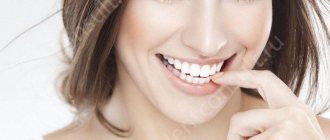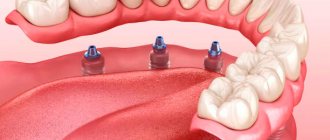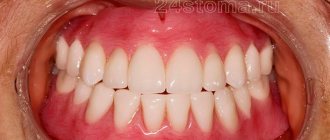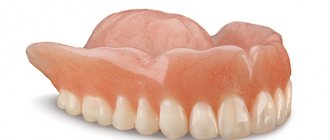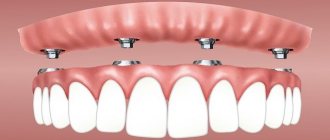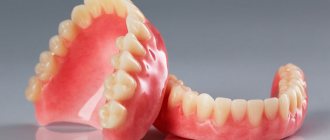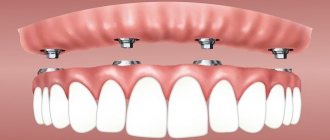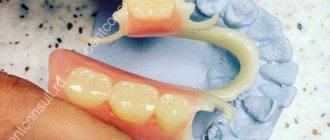From this article you will learn:
- what material are removable dentures made of?
- what types of dentures are there?
- What is the difference between dentures on implants and other removable dentures?
- conditionally removable dentures,
- how to choose the best modern and reliable prostheses,
- how to care for removable dentures,
- Prices for removable dentures in 2021.
About removable dentures
Removable dentures are a type of prosthetics that is carried out when teeth are partially or completely lost. Their feature is the ability to remove the denture (with the exception of some models). They are quite easy to care for. However, removable dentures require careful cleaning and oral hygiene. The advantages of this type of prosthetics:
- high aesthetic indicators;
- uniform load when chewing and, as a result, prevention of bone atrophy;
- individual production for each client;
- easy to care for;
- affordable price;
- quickly installed;
- short period of adaptation.
Today there are a large number of types of prostheses and materials from which these structures are made.
Removable dentures - what are they?
Removable dentures are devices that partially or completely replace lost teeth. A distinctive feature of removable structures is the ability for the patient to remove and put them on independently. This feature unites all types of removable dentures with a significant variety of types and models.
Despite the advantages of modern fixed prosthetics, removable dentures also have their advantages:
- relatively low price;
- ease of manufacture and operation of the orthopedist;
- the ability to choose a manufacturing material that is suitable in price and quality;
- the ability to restore any defect in the dentition;
- lightness of the prosthesis, the ability to choose the desired shade of material;
- no need to prepare healthy teeth for prosthetics;
- the ability to repair a damaged model in a dental laboratory;
- ease of care.
Removable dentures solve the problem of restoring the aesthetic and chewing function of teeth when they are lost and it is impossible to establish a fixed model, and therefore increase the quality of human life.
Structural materials in prosthetics
A modern dentist has a sufficient amount of materials for making dentures in his arsenal.
In modern prosthetics, materials such as: Plastic are used. Used for the manufacture of temporary crowns, and removable acrylic and nylon structures. Plastic products do not last long, so they will need to be replaced after a while.
Metal. Gold-containing and cobalt-chromium alloys are widely used. Metal crown frames and clasp dentures are very common.
Zirconium. Zirconium oxide and dioxide are ideal materials for restoring dentition in the chewing area. The ceramic coating of zirconium crowns gives the product a natural shine.
Ceramics. This material is valued for its properties that are as close as possible to natural tooth enamel. For ceramic products, you can easily choose the desired shade. The main disadvantage of ceramics was previously considered to be low strength, but with the beginning of the use of sodium disilicate in prosthetics, this parameter improved. A good example of the use of ceramics is E-Max crowns.
Which dental prosthetics is better and cheaper is a question that only his attending physician can answer for each patient. Much depends on the location of installation - anterior or chewing teeth, the level of qualifications of the specialist and the nuances of a specific clinical situation.
Indications for removable prosthetics
Removable dentures are installed when:
- the absence of several teeth in the dentition and the impossibility of fixed prosthetics;
- the patient’s refusal of fixed prosthetics;
- complete loss of teeth - adentia;
- loss of a large number of teeth (immediate denture);
- loss of one tooth (aesthetic prosthesis);
- for infectious-inflammatory and degenerative-dystrophic diseases of periodontal tissues (periodontitis or periodontal disease);
- severe general diseases that are contraindications for fixed prosthetics;
- individual intolerance to metal structures.
Removable dentures will be an ideal option if you lose several lateral teeth in a row on both sides or if you lose central teeth while keeping the lateral ones. This type of prosthetics is also very suitable for edentulous patients, if the patient refuses implantation.
Disadvantages of removable prosthetics
Despite the simplicity and ease of installation of removable dentures, these designs have more disadvantages than advantages:
- the inability to create a uniform load on the jaw tissue, which gradually leads to their atrophy (decrease in volume) and the need to change the model (limited validity period);
- insufficiently reliable fixation in the oral cavity, which often creates problems when chewing and unclear speech;
- difficult process of getting used to wearing; some sensitive people cannot get used to a foreign object in the oral cavity due to injury to soft tissues;
- It is impossible to carry out prosthetics immediately after tooth extraction, as is the case with one-stage implantation.
Removable dentures should be installed only when there are no other prosthetic options, since there are contraindications for installing bridges or prosthetics on implants.
Choice according to indications and budget
The best dentures are those that are indicated for the patient. Generally speaking, the most modern designs will be those based on implants. However, there are two very important points here: implantation has a number of limitations and is considered an expensive procedure (especially if we are talking about complete dental restoration). In this case, other designs come to the rescue, which are also designed to restore functionality and aesthetics. Before we start talking about the different systems in more detail, we need to make some distinctions so that you don't get confused.
All dentures are usually divided into several types. First of all, the number of teeth being replaced is taken into account: this criterion implies the installation of a partial or complete denture. According to the method of removing the structure from the oral cavity, removable and conditionally removable dentures are distinguished. Which ones are better - read on.
Types of removable prosthetics
Features of dental prosthetics with removable dentures largely depend on the type of structure, material of manufacture, and method of fixation in the oral cavity.
By type of design
There are two types of models: plate and clasp.
Plate removable dentures
Lamellar (lamellar) are the very first models. Their design is very simple, it consists of a base - plastic, repeating the relief of the gums and palate and artificial crowns installed on them. Constructions of this type are divided into:
Complete and partially removable plate dentures
- complete removable dentures – in case of complete absence of teeth;
- partially removable dentures – if some of the teeth are preserved; one of the modern options is sandwich dentures that do not cover the palate;
- immediate dentures (butterflies, micro dentures) – for 1 – 2 adjacent teeth.
Installation of these models in the oral cavity is easy: the orthopedist makes an impression of the jaw, a model is made from it in a dental laboratory, the orthopedist first tries it on, then installs it. The patient fixes the model by clenching his teeth. Partially removable models are fixed on the preserved teeth using special clasps. After which the patient begins to gradually get used to the new design. Caring for the plate model is quite complicated; it is carried out daily by the patient himself and professional cleaning is carried out twice a year.
- Pros: lightweight, easy to install prosthesis.
- Cons: you have to change it often (at least once every 3 years, sometimes more often), the fixation is unreliable.
Clasp removable dentures
Clasp dentures are modern partially removable dentures, consisting of a plastic base with artificial crowns installed on it, an arched metal frame and hook-clasps fixing the structure on the supporting teeth. A metal arch (clasp) allows you to create the desired load on the jaw tissue. A modern option is the metal-free Quadrotti clasp, where all parts are made of high-strength plastic.
Conventional clasp prosthesis
Metal-free Quadrotti
Installation is more difficult, since it is necessary to prepare the supporting teeth. Caring for the clasp does not require any special skills; it is enough to do it regularly.
- Pros: proper distribution of the load on the jaw prevents bone tissue atrophy, so the structure can last a long time (at least 5 years, but more often much longer), there is no massive plastic base that disrupts taste, lightness and beautiful appearance, reliable fixation in the oral cavity.
- Cons: requires getting used to, sometimes the fixing elements are visible when you smile, high cost.
By fixation method
A full plate removable denture is attached to the oral cavity as follows:
- by removing air between the orthopedic structure and the tissues in the oral cavity while clenching the jaws; this design is called “suction cup”; good fixation is achieved only if all the bends of the structure fully correspond to the bends of the patient’s oral tissues;
- using special fixing adhesives and creams, strips and gaskets.
A partially removable denture is fixed on the supporting teeth using hooks (clasps). Clasp removable dentures are fixed in different ways. According to this principle, all clasp partial removable dentures are divided into the following designs:
Clasps on clasps, attachments and telescopic crowns
- on clasps - hooks securely fix the model on the supporting teeth, but can be noticeable when smiling;
- on attachment locks - complex locks are fixed on supporting teeth covered with crowns, so they are practically invisible; the design is complex to manufacture and therefore expensive;
- on telescopic (retractable) crowns - the most difficult manufacturing option, requiring grinding of the supporting teeth and installing crowns on them.
Conditionally removable models on implants are screwed to titanium roots installed during implantation. They can be removed by the dentist during medical examinations for cleaning. The patient cannot remove them on his own, which is why they are called conditionally removable.
By material
The very first models were made from rubber. Today, plate structures are made from various types of plastics. Certain requirements have been developed for plastic dental materials. They should be:
- durable, able to withstand chewing loads;
- securely connecting to artificial crowns;
- not deformed during wearing;
- non-irritating to periodontal tissues;
- without toxic or allergic effects.
The following materials meet these requirements (partially or fully):
Acrylic removable dentures for teeth
Acrylic is a type of plastic that has replaced rubber in the manufacture of removable dentures. It became widespread in the late 30s of the last century. It causes allergies due to the component contained in the coloring substance, but acrylic without color is also available, which is less aesthetically pleasing, but does not cause allergies.
- Pros: an acrylic prosthesis has a number of advantages compared to a rubber one: it is more durable, aesthetically pleasing, and it is easy to make an inexpensive removable model from it.
- Disadvantages: the material is not elastic enough and during the process of getting used to it often causes tissue irritation;
- during the entire time of wearing, it releases a non-protein substance (monomer), which combines with tissue proteins and causes toxic-allergic reactions;
- The high porosity of acrylic contributes to the accumulation of bacteria on its surface and the development of infectious and inflammatory processes in the oral cavity.
Nylon Removable Dentures
Nylon - removable models began to be made from this type of plastic in the mid-80s of the last century.
Pros - nylon prostheses are more plastic, do not have pronounced porosity, are non-toxic, and hypoallergenic.
Minuses:
- excessive flexibility creates problems in the form of uneven distribution of load and gradual atrophy of the jaw bone tissue;
- the device is not always securely held in the oral cavity.
Acry-Free dentures
Acry-Free (acrylic-free plastic) is a modern thermoplastic material that does not contain acrylic.
- Pros: hypoallergenic, durable, elastic, fits perfectly to the tissues in the oral cavity, is smooth (bacteria do not linger on it), does not irritate the tissue, structures made from it can look like natural ones.
- The downside is the higher cost.
The following materials are used for the manufacture of clasp models:
- Plastic - for the manufacture of the base, mainly high-strength types of plastic manufactured using high technology are used. From these types of plastic it is also possible to make a completely metal-free clasp dental prosthesis Quadrotti. The most famous materials: acetal (acetate plastic) - a modern plastic that has increased resistance to stress, while not causing allergic reactions and tissue irritation; has a wide selection of color shades, very aesthetic; minus – high cost;
- Dental D (white plastic) – an even more durable, elastic material with excellent aesthetic qualities; minus - expensive.
What material is it made from?
The most important characteristics of removable structures, such as secure fixation, wearing comfort and aesthetics, are determined by the materials from which these structures are made.
Plastic
Acrylic plastic is used to make plastic dentures. This option can be used for both complete and partial edentia.
The prosthesis is secured using the “suction effect”. The patient bites down on the denture, excess air comes out of it, and a tight fit to the gum is ensured.
Acrylic
The most popular and affordable dentures are acrylic. Used to restore partially lost teeth.
Pros:
- low cost;
- ease of manufacture and operation;
- good aesthetics - acrylic does not change its properties over time, and is not stained by coffee, tea or cigarettes.
Reviews of acrylic dentures are generally good, except for the possibility of allergies, which is why some patients remove them at night.
The photo shows an acrylic prosthesis
Nylon
Soft dentures are made from elastic nylon. They can be used for both partial and complete absence of teeth.
The positive aspects of nylon prostheses are:
- good level of elasticity;
- they are thinner and lighter compared to other materials;
- high flexibility.
These properties increase wearing comfort. However, this material has more negative aspects than positive ones. Firstly, the healing of the structure: due to the soft elastic nylon, the gums are greatly deformed, so bone resorption may even occur. Secondly, chewing food is often accompanied by pain. Finally, nylon dentures have to be adjusted frequently.
The photo shows a nylon prosthesis
Аcryfree
Acri-free - modern nylon prostheses. This material was first developed by an Israeli company. They occupy an intermediate position between plastic and nylon structures, incorporating their best qualities. Such structures are made from advanced acrylic plastic. They have a slightly greater degree of flexibility than acrylic ones.
Among the advantages they note:
- high aesthetic properties;
- wearing comfort;
- almost invisible thanks to the translucent material.
The photo shows an AcryFree nylon prosthesis
Spofadent
A new version of dentures, which includes three-layer plastic, which gives Spofadent dentures high strength. The material shows high aesthetic properties: it can be easily painted in various shades of pink and white. Dentures made from Spofadent are practically not exposed to chemicals contained in soda, drinks and food. Like Acryfree, this material is translucent, so it is excellent for prosthetics of front teeth.
Ivobase
It is an organic thermoplastic material, the chemical name of which is polymethyl methacrylate. The manufacturing technology of this material itself makes it possible to reduce allergic reactions and eliminate errors when installing dentures (overbite or excessive shrinkage).
Moreover, structures made from Ivobase have increased strength and low porosity, so the material is not stained by pigments contained in food and is slightly susceptible to bacterial attack. Such prostheses have high biocompatibility, quality and wearing comfort.
Vertex
Vertex is a modern thermoplastic material that is manufactured without the use of monomers, which ensures the absence of allergies, burning and itching when worn. Patients do not experience a feeling of dryness, articulation and taste perception are not impaired when using prostheses from Vertex. This material is stronger than other plastic structures, so manufacturers can make the base as thin as possible. You can choose shades of white and pink for each specific occasion. The material has good properties and is therefore suitable for full and partial prosthetics.
The photo shows the Vertex prosthesis
Deflex
The material comes from Argentina. It contains modern innovative thermoplastic polyamide. The base of such dentures is made completely transparent, and if desired, you can give it a pink tint. Such dentures are more flexible and durable than acrylic structures. They are recommended for police officers, firefighters, boxing athletes and other people with traumatic professions. However, this material has several disadvantages:
- ability to absorb odors;
- inability to repair the prosthesis.
Deflex is recommended for use only for partial dentures. However, if other teeth are lost, the entire prosthesis will have to be redone.
The photo shows the Deflex prosthesis
The best removable dentures
After the examination, the orthopedic dentist advises the patient which removable dentures to choose. It is worth listening to these recommendations, since all types of prosthetics have their own indications and contraindications.
Removable dentures for complete absence of teeth
If the patient is completely missing all the teeth in the dentition, then the best option would be conditionally removable prosthetics on implants - all on 4 or all on 6. 4 or 6 titanium roots are implanted into the jaw, after which a model is screwed onto them, completely replicating the anatomy of the jaw. Such teeth are practically no different from natural ones. They do not require daily removal for cleaning; regular oral care and professional cleaning of the model every six months are sufficient. The only disadvantage of conditionally removable prosthetics is its relatively high cost.
If full implantation is not affordable, you can also install a complete removable denture with suction cups. To do this, on the advice of a doctor, you need to select the most suitable plastic for making the model, carefully take an impression so that all the anatomical features of the jaw and oral tissues are fully reflected in the future design. Then, when the jaws are clenched, air is displaced, the structure collapses with the tissues, sticks to them and provides fixation. This type of design can be taken off and put on daily.
To install a removable denture in the absence of teeth, it is not recommended to use nylon structures, since they cannot fully support the chewing function and do not prevent atrophy of the jaw bone tissue.
With partial absence of teeth
The question of which removable dentures are better for incomplete edentia is also decided by the doctor. The best option would be the metal-free clasp Quadrotti model. This is a unique design, very reliable, correctly regulating the load on the tissue. The only negative is the high cost.
Option number two is a regular clasp model using metal. The clasp is also reliable, aesthetically pleasing and does not cause any discomfort when worn. The downside is that it's also not cheap.
A budget option is a plate model made of acrylic. It is also reliable, but not durable and often causes toxic-allergic reactions. To avoid allergies, you can install a colorless acrylic structure, which does not have an entirely aesthetic appearance. If 1–2 teeth are missing, then a butterfly microprosthesis made from any type of plastic can be installed.
Which removable denture is best for the upper and lower jaw?
Any option is suitable for the upper jaw, since there is a significant space behind the back surface of the teeth that allows removable dentures of any type to be securely fixed. But it is still better to give preference to conditionally removable prosthetics on implants. A removable denture for the upper jaw can also be a clasp denture.
Prosthetics on the lower jaw are more problematic; there is no necessary space for fixation, therefore, deciding which removable dentures are better should be entrusted to an orthopedist. The options to choose from are conditionally removable prosthetics on implants and any type of clasp.
Why is complete absence of teeth dangerous?
It is necessary to restore the dentition in case of edentia, and this must be done as quickly as possible. The absence of even one tooth can cause serious health problems, let alone complete edentia.
· Bone tissue atrophy. Without the necessary load on the jaw, the bone tissue begins to thin out, and subsequently it will be very difficult to restore chewing function through implantation. You will have to specifically build up the bone tissue surgically, and this is an additional waste of money and time.
· Disorders of the digestive system. A person will have to give up many foods, and poor digestion of poorly chewed food will negatively affect the condition of the gastrointestinal tract.
· Changes in appearance. Distortion of the oval of the face, protrusion of the chin, sunken cheeks and compressed lips are characteristic facial features of a patient with complete edentia.
· Distortion of speech. Teeth are involved in the formation of sounds. Their absence greatly affects articulation.
As a result, speech becomes lisping and the person cannot pronounce a number of sounds.
Such troubles form a huge number of complexes in a person. His quality of life and communication skills are declining. The only way to get rid of all restrictions is complete prosthetics.
How to get used to removable dentures
Adaptation is necessary for complete removable prosthetics, as well as for direct prosthetics, when the patient has lost more than half of his teeth. The adaptation period for each patient has its own individual characteristics and duration. On average, it lasts from three weeks to two months. In this case, it is necessary to distinguish between normal physiological reactions to the presence of a foreign object in the oral cavity and pathological processes that require immediate consultation with a doctor.
Normal adaptation
During the adaptation period, the body gradually gets used to removable dentures, which is accompanied by a number of physiological reactions. In each patient, these reactions may be more or less pronounced, and some of them may be absent. Normal adaptation symptoms:
- feeling of discomfort in the mouth;
- drooling or, conversely, increased dry mouth - depends on the mechanical effect of the structure on the salivary glands;
- moderate pain that appears when chewing - it can be due to the pressure of the model on the gums or muscle spasm;
- loss of taste - often occurs when installing a complete removable plate denture that covers the taste buds in the palate;
- nausea and gag reflex - this does not occur in everyone, but if it persists for a long time, the dentist may decide to remove the structure;
- gum irritation;
- slurred speech;
- prolonged stress against the background of difficult adaptation.
No matter what removable dentures are installed, there will always be adaptation. To reduce adaptation symptoms, you need to:
- strictly adhere to the rules of oral care recommended by the orthopedist;
- if the unpleasant symptoms do not bother you too much, it is better not to remove the structure at night for the first few days - this will allow adaptation to happen faster;
- to suppress the gag reflex, use a breathing technique: inhale slowly through the nose for 4 seconds, hold your breath for 3 seconds, exhale slowly through the mouth - 6 seconds; breathe like this until the urge to vomit passes;
- to eliminate problems with salivation when it increases, rinse your mouth with saline solution (a level teaspoon per glass of water); if you are dry, you need to drink more regular boiled water;
- to eliminate pain and discomfort when chewing, eat only soft and liquid foods in the first week; You can gradually introduce more solid foods, but you will have to give up nuts and seeds forever;
- to strengthen the gums, massage: remove the removable denture, rinse your mouth, massage the gums with your fingertips for 5 minutes; this will improve blood circulation and prevent the development of irritation;
- to eliminate irritation and prevent inflammatory processes, use special dental gels, for example, Metrogyl Denta;
- to improve diction - from the first day of installing a removable denture, talk and read aloud more; Over time, speech will be restored.
Pathological processes during adaptation
A removable dental process installed on the jaw can cause severe irritation of the gums, which is often accompanied by infection. Symptoms of this complication may be: increasing pain when chewing, persisting after eating, redness and swelling of the gums, discharge of pus, and sometimes a slight increase in body temperature. Such symptoms cannot be tolerated, since the infection can spread to other organs and tissues with the development of purulent inflammatory processes. The only correct solution in this situation would be to urgently consult a dentist to treat the complication.
Glue and cream for fixing removable dentures
Models with suction cups sometimes require additional fixation. For this purpose, special fixing gels, adhesives and strips are produced. The decision on the use of such means is made by the orthopedist, who also selects the most suitable means and teaches the patient how to use it. The most popular means for fixation:
- Protefix (manufacturer: Queisser Pharma, Germany) – fixing cream with a strong immediate effect lasting from 8 to 12 hours; the price of a 47 g tube is about 230 rubles;
- Rox (BONYF, Liechtenstein) – fixing cream, lasts at least 12 hours, price about 250 rubles;
- Fittydent (FittyDent International, Austria) - considered one of the best fixation creams, lasts 12 hours, price for a 40 g tube is about 250 rubles.
Means for fixing prostheses
When using fixative creams, they must be applied strictly in accordance with the instructions. Most creams are used like this:
- Rinse and dry the structure.
- Apply a little cream to the surface of the removable denture attached to the tissue.
- Rinse your mouth.
- Place the removable denture on the jaw and bite hard for 5–6 seconds.
Instructions for use of fixing creams
Caring for removable dentures after prosthetics
After completion of removable dentures, the patient needs to carry out regular daily care of removable dentures. If this is not done or done irregularly, the structure will quickly become unusable or become a source of infection. Partial and complete removable dentures are more difficult to care for than fixed dentures. Necessary:
- remove the structure twice a day, wash it, clean it with a toothbrush with soft bristles and toothpaste without abrasive properties; put on after rinsing the mouth with an antiseptic;
- After each meal, rinse your mouth with water, and it is better to also remove and rinse the denture with water;
- For the first few days, it is better not to remove the structure at night; when the main adaptation period has passed, it can be removed and placed overnight in a special container with a disinfectant solution (tablets for preparing a disinfectant solution are sold at the pharmacy);
- Every 6 months cleaning should be done professionally in your dentist's office.
- If any complaints arise that require consultation with a dentist, the device must be worn for at least three hours in a row so that the cause of the discomfort is clear to the doctor.

